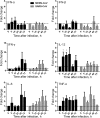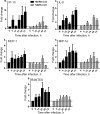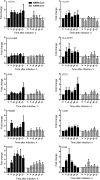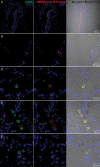Active replication of Middle East respiratory syndrome coronavirus and aberrant induction of inflammatory cytokines and chemokines in human macrophages: implications for pathogenesis
- PMID: 24065148
- PMCID: PMC7107356
- DOI: 10.1093/infdis/jit504
Active replication of Middle East respiratory syndrome coronavirus and aberrant induction of inflammatory cytokines and chemokines in human macrophages: implications for pathogenesis
Abstract
Middle East respiratory syndrome coronavirus (MERS-CoV) infection caused severe pneumonia and multiorgan dysfunction and had a higher crude fatality rate (around 50% vs. 10%) than SARS coronavirus (SARS-CoV) infection. To understand the pathogenesis, we studied viral replication, cytokine/chemokine response, and antigen presentation in MERS-CoV-infected human monocyte-derived macrophages (MDMs) versus SARS-CoV-infected MDMs. Only MERS-CoV can replicate in MDMs. Both viruses were unable to significantly stimulate the expression of antiviral cytokines (interferon α [IFN-α] and IFN-β) but induced comparable levels of tumor necrosis factor α and interleukin 6. Notably, MERS-CoV induced significantly higher expression levels of interleukin 12, IFN-γ, and chemokines (IP-10/CXCL-10, MCP-1/CCL-2, MIP-1α/CCL-3, RANTES/CCL-5, and interleukin 8) than SARS-CoV. The expression of major histocompatibility complex class I and costimulatory molecules were significantly higher in MERS-CoV-infected MDMs than in SARS-CoV-infected cells. MERS-CoV replication was validated by immunostaining of infected MDMs and ex vivo lung tissue. We conclusively showed that MERS-CoV can establish a productive infection in human macrophages. The aberrant induction of inflammatory cytokines/chemokines could be important in the disease pathogenesis.
Keywords: MERS-CoV; SARS-CoV; cytokine and chemokine response; pathogenesis; viral replication.
Figures







Similar articles
-
Attenuated Interferon and Proinflammatory Response in SARS-CoV-2-Infected Human Dendritic Cells Is Associated With Viral Antagonism of STAT1 Phosphorylation.J Infect Dis. 2020 Aug 4;222(5):734-745. doi: 10.1093/infdis/jiaa356. J Infect Dis. 2020. PMID: 32563187 Free PMC article.
-
Activation of C-Type Lectin Receptor and (RIG)-I-Like Receptors Contributes to Proinflammatory Response in Middle East Respiratory Syndrome Coronavirus-Infected Macrophages.J Infect Dis. 2020 Feb 3;221(4):647-659. doi: 10.1093/infdis/jiz483. J Infect Dis. 2020. PMID: 31562757 Free PMC article.
-
Delayed induction of proinflammatory cytokines and suppression of innate antiviral response by the novel Middle East respiratory syndrome coronavirus: implications for pathogenesis and treatment.J Gen Virol. 2013 Dec;94(Pt 12):2679-2690. doi: 10.1099/vir.0.055533-0. Epub 2013 Sep 28. J Gen Virol. 2013. PMID: 24077366
-
Middle East respiratory syndrome coronavirus infection: virus-host cell interactions and implications on pathogenesis.Virol J. 2015 Dec 22;12:218. doi: 10.1186/s12985-015-0446-6. Virol J. 2015. PMID: 26690369 Free PMC article. Review.
-
Contribution of monocytes and macrophages to the local tissue inflammation and cytokine storm in COVID-19: Lessons from SARS and MERS, and potential therapeutic interventions.Life Sci. 2020 Sep 15;257:118102. doi: 10.1016/j.lfs.2020.118102. Epub 2020 Jul 18. Life Sci. 2020. PMID: 32687918 Free PMC article. Review.
Cited by
-
Middle East Respiratory Syndrome Coronavirus Efficiently Infects Human Primary T Lymphocytes and Activates the Extrinsic and Intrinsic Apoptosis Pathways.J Infect Dis. 2016 Mar 15;213(6):904-14. doi: 10.1093/infdis/jiv380. Epub 2015 Jul 22. J Infect Dis. 2016. PMID: 26203058 Free PMC article.
-
High secretion of interferons by human plasmacytoid dendritic cells upon recognition of Middle East respiratory syndrome coronavirus.J Virol. 2015 Apr;89(7):3859-69. doi: 10.1128/JVI.03607-14. Epub 2015 Jan 21. J Virol. 2015. PMID: 25609809 Free PMC article.
-
Middle East respiratory syndrome coronavirus: another zoonotic betacoronavirus causing SARS-like disease.Clin Microbiol Rev. 2015 Apr;28(2):465-522. doi: 10.1128/CMR.00102-14. Clin Microbiol Rev. 2015. PMID: 25810418 Free PMC article. Review.
-
The Potential of Probiotics as Ingestible Adjuvants and Immune Modulators for Antiviral Immunity and Management of SARS-CoV-2 Infection and COVID-19.Pathogens. 2023 Jul 11;12(7):928. doi: 10.3390/pathogens12070928. Pathogens. 2023. PMID: 37513775 Free PMC article. Review.
-
Defining the Innate Immune Responses for SARS-CoV-2-Human Macrophage Interactions.Front Immunol. 2021 Oct 4;12:741502. doi: 10.3389/fimmu.2021.741502. eCollection 2021. Front Immunol. 2021. PMID: 34671355 Free PMC article.
References
-
- Zaki AM, van Boheemen S, Bestebroer TM, Osterhaus AD, Fouchier RA. Isolation of a novel coronavirus from a man with pneumonia in Saudi Arabia. N Engl J Med. 2012;367:1814–20. - PubMed
-
- World Health Organization. Middle East respiratory syndrome coronavirus (MERS-CoV)—update. 1 August 2013. http://www.who.int/csr/don/2013_08_01/en/index.html . Accessed 27 September 2013.
-
- Woo PC, Lau SK, Huang Y, Yuen KY. Coronavirus diversity, phylogeny and interspecies jumping. Exp Biol Med (Maywood) 2009;234:1117–27. - PubMed
Publication types
MeSH terms
Substances
LinkOut - more resources
Full Text Sources
Other Literature Sources
Miscellaneous

